Xfce
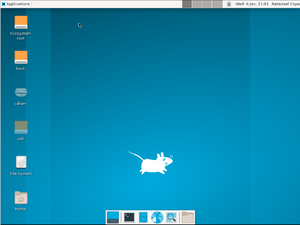
Xfce is a lightweight desktop environment for UNIX-like operating systems. It aims to be fast and low on system resources, while still being visually appealing and user friendly.
The Alpine Linux script for quickly setting up a desktop is:
# setup-desktop
On running the above command, you will be prompted to select a desktop environment.
Which desktop environment? ('gnome', 'plasma', 'xfce', 'mate', 'sway', 'lxqt' or 'none') [none]
Once you have chosen a desktop environment, this script installs the chosen desktop along with necessary packages, firefox browser and adds necessary services to run on startup. You can reboot when complete, and the system will boot into a graphical login screen with the chosen desktop environment, except for sway. To view the packages installed by the script: $ cat /usr/sbin/setup-desktop
When xfce is chosen, the above utility also installs lightdm as display manager and most of the steps listed below in the Manual installation are completed.
Manual installation
Prerequisites
- Install Xorg
- Install and configure D-Bus (without D-Bus icons and keyboard shortcuts may be missing)
Typical minimal package selection to install:
# apk add xfce4 xfce4-terminal xfce4-screensaver lightdm-gtk-greeter
xfce4-screensaver may also be necessary just for screen locking after inactivity (with no screensaver enabled).
lightdm-gtk-greeter may be omitted if Xfce should only be started from or after a command line login, i.e. the machine should not boot to a graphical login screen (display manager). However, it is then necessary to add some theme files instead, to get a proper (themed) appearance. By default, there is no theme and Adwaita icon in Settings -> Appearance, but Adwaita is missing some icons for XFCE. Install adw-gtk3 for basic themes and adwaita-xfce-icon-theme for basic icons.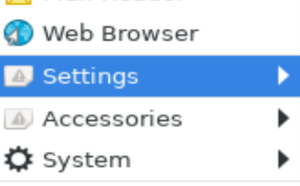
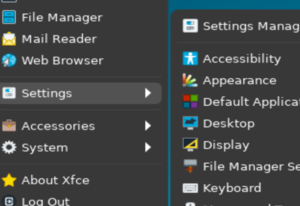
Setting up eudev as device manager on a desktop system is recommended. The alpine-conf package provides setup-devd script to easily install and setup device managers.
To set up eudev, issue the command:
# setup-devd udev
Starting Xfce
With a display manager (graphical login)
If the package lightdm-gtk-greeter has been installed per the instructions above, the lightdm display manager may be started to log in graphically with your new user.
# rc-service lightdm start
After correct operation is verified, lightdm can be enabled to start up during boot:
# rc-update add lightdm
From the command line
Xfce may be started with:
$ startx
If you want to start it via another script or mechanism like xinit, use startxfce4. e.g. call it via exec startxfce4 at the end of the ~/.xinitrc configuration file.
Localized keyboard layout
Settings->Keyboard->Layout->"Keyboard layout" seems to get activated only after once temporarily switching on the "Use system defaults" button, logging out and in again, and then turning it off.
Allowing shut down and reboot
To enable users to shut down the machine or reboot, the packages elogind and polkit-elogind need to be installed.
# apk add elogind polkit-elogind
A reboot is required to let it take effect.
# lbu commit # if running in diskless mode, to save state $ reboot
Auto-mounting USB drives
To enable automatic mounting of USB drives, install these packages:
# apk add gvfs udisks2
Depending on what devices you intend to mount, some additional packages may be needed:
# apk add \ ntfs-3g \ # Stable, full-featured, read-write NTFS (driver) gvfs-cdda \ # CDDA support for gvfs gvfs-afp \ # AFP support for gvfs gvfs-goa \ # GNOME Online Accounts support for gvfs gvfs-mtp \ # MTP support for gvfs gvfs-smb \ # Windows fileshare support for gvfs gvfs-lang \ # Languages for package gvfs gvfs-afc \ # Apple mobile devices support for gvfs gvfs-nfs \ # NFS support for gvfs gvfs-dev \ # Backends for the gio framework in GLib (development files) gvfs-archive \ # Archiving support for gvfs gvfs-dav \ # WebDAV support for gvfs gvfs-fuse \ # FUSE support for gvfs gvfs-gphoto2 \ # gphoto2 support for gvfs gvfs-avahi \ # DNS-SD support for gvfs
To list descriptions of all gvfs- packages:
$ apk info -d gvfs-*
Make sure that mounting is enabled in
Thunar>Edit>Preferences>Advanced>Volume Management>Configure>Storage>Removable Storage
Network browsing
For browsing of network shares within XFCE that works seamlessly with file associations, you can install the gvfs packages for the network protocols you use.
For example, to browse in a SMB/cifs windows network:
# apk add gvfs-smb
(Check: If the above may already be sufficient for gvfs to initiate the fuse kernel module. Else, try to identify if there are necessary steps in:)
# apk add gvfs-fuse
The OpenRC script for fuse is in a separate package.
# apk add fuse-openrc
Then the fuse service can be started manually.
# rc-service fuse start
(The XFCE sessions already in progress need to be restarted for this to take effect, i.e. log out and log in again.)
If it works, the fuse service can be added to start up automatically at boot time:
# rc-update add fuse
Enabling privilege escalation GUI
In other popular Linux distributions, such as Ubuntu Server, this comes by default when you install minimal XFCE, but if you install XFCE on Alpine using the instruction on this page, it is not included, and the GUI application that needs root access fails with a message like "permission denied". You can test this with the default Thunar file manager by installing gvfs, which is needed for things like Trash or browsing SMB network share, and then typing admin:// in the address bar.
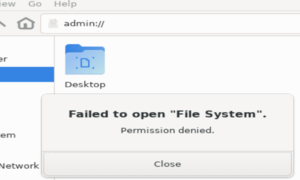
To enable the privilege escalation GUI for a doas/sudo user, you need to install elogind, polkit-elogind, xfce-polkit, and lightdm. Note that elogind and lightdm must be running before logging into the XFCE desktop, otherwise you will see an empty error dialogue box at login.

To make elogind/lightdm running, either make them start automatically at system start:
# rc-update add elogind #change elogind for lightdm and run the same command
or start them manually for this time only:
# rc-service elogind start #change elogind for lightdm and run the same command
Now, make sure in Settings -> Session and Startup -> Application Autostart, "XFCE PolKit" exists and checked. If it is not found, navigate to /etc/xdg/autostart and check if xfce-polkit.desktop exists and its size is not 0. If everything above has been done, when you type admin:// in the address bar, you will see the password dialogue.
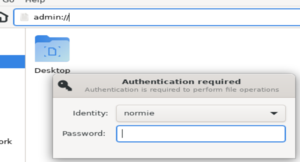
Troubleshooting
Missing Icons
By default xfce needs the adwaita-icon-theme, otherwise some icons might be missing,
# apk add adwaita-icon-theme
Startup
If the Xorg server segfaults in kvm/qemu then add nomodeset as a boot option.
If the mouse / keyboard is not responding, you can try disabling hotplug.
Section "ServerFlags"
Option "AutoAddDevices" "False"
EndSection
Login
If you are unable to login, check /var/log/lightdm/lightdm.log, there may be output there from X to indicate failed modules, etc.
If you are unable to login, or you see an error "Failed to execute login command", you should check ~/.xinitrc (if you're using .xinitrc) with your preferred text editor (vi, nano, etc) and ensure that it is set to load xfce. To do this, the 'exec' line (usually the last line in the file) should read exec startxfce4. If ~/.xinitrc does not exist, create it and add the exec line. this command will do it:
$ echo "exec startxfce4" >> ~/.xinitrc
Session
If the panel and windows disappear or start flickering after logging in to xfce the first time, log out, and then log in again. That happens because xfce is writing a default config file with the compositor enabled, but does not enable it during your first login. Clear out the ~/.config/xfce directory, and login as "first time" again, as the default vblank setting for the compositor is likely incorrect. Open the windows manager tweaks and dconf editor (or use dconf-query) before you log out. Tick the compositor to off in the window manager tweaks ui. If you have a recent enough xfce (4.14) there is a ui in window manager tweaks to set syncing mode, and you can try different values, such as vblank, xpresent, and glx, while turning the compositor on and off, until you find one that works. Or, from dconf editor, you can set xfwm4 /general/vblank_mode, which you will find is set to "auto" by default, and then turn the compositor on again. This can also be accomplished from the command line using using:
$ xfconf-query -c xfwm4 -p /general/vblank_mode -s mode
where mode is vblank, glx or xpresent.
You have to use xfconf-query from within the xfce terminal session, or at least with the xfce settings daemon started.